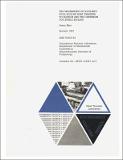| dc.contributor.author | Shai, Isaac | en_US |
| dc.contributor.other | Massachusetts Institute of Technology. Engineering Projects Laboratory. | en_US |
| dc.contributor.other | Massachusetts Institute of Technology. Heat Transfer Laboratory. | en_US |
| dc.date.accessioned | 2011-03-04T23:32:06Z | |
| dc.date.available | 2011-03-04T23:32:06Z | |
| dc.date.issued | 1967 | en_US |
| dc.identifier | 14135687 | en_US |
| dc.identifier.uri | http://hdl.handle.net/1721.1/61465 | |
| dc.description.abstract | A comparison between liquid metals and other common fluids, like water, is made as regards to the various stages of nucleate pool boiling. It is suggested that for liquid metals the stage of building the thermal layer plays the most significant part in transfer heat from the solid. On this basis the transient conduction heat transfer is solved for a periodic process, and the period time is found to be a function of the degree of superheat, the heat flux, and the liquid thermal properties. A simplified model for stability of nucleate pool boiling of liquid metals has been postulated from which the minimum heat flux for stable boiling can be found as a function of liquid-solid properties, liquid pressure, the degree of superheat, and the cavity radius and depth. Experimental tests with sodium boiling from horizontal surfaces containing artificial cavities at heat fluxes of 20, 000 to 300, 000 BTU/ft hr and pressures between 40 to 106 mm Hg were obtained. At relatively low heat fluxes, convection currents have significant effects on the period time of bubble formation. An empirical correlation is proposed, which takes into account the convection effects, to match the experimental results. Some recorded temperature variations in the solid close to the surface during stable nucleate boiling are presented. | en_US |
| dc.description.sponsorship | Sponsored by the Atomic Energy Commission DSR | en_US |
| dc.format.extent | 159 p | en_US |
| dc.publisher | Cambridge, Mass. : M.I.T. Engineering Projects Laboratory, [1967] | en_US |
| dc.relation.ispartofseries | Technical report (Massachusetts Institute of Technology, Heat Transfer Laboratory) ; no. 45. | en_US |
| dc.subject | Boiling-points. | en_US |
| dc.subject | Heat -- Transmission. | en_US |
| dc.subject | Liquid metals. | en_US |
| dc.title | Mechanism of nucleate pool boiling heat transfer to sodium and the criterion for stable boiling | en_US |
| dc.type | Technical Report | en_US |
